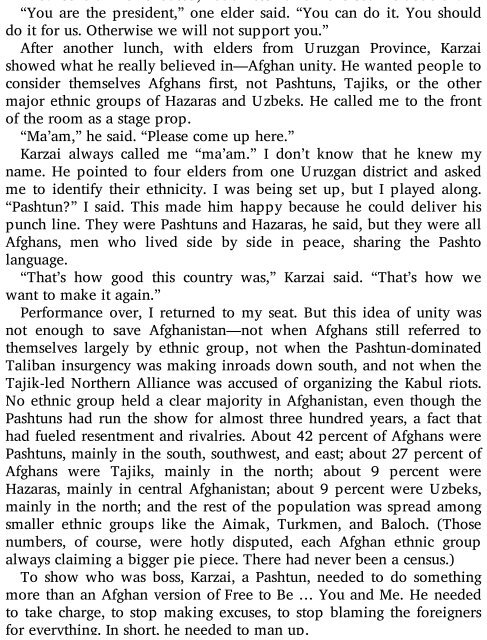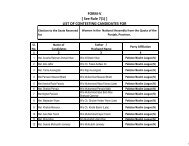the_taliban_shuffle_-_kim_barker
the_taliban_shuffle_-_kim_barker
the_taliban_shuffle_-_kim_barker
Create successful ePaper yourself
Turn your PDF publications into a flip-book with our unique Google optimized e-Paper software.
“No!” several men shouted, not unless Karzai reversed his decision.<br />
“You are <strong>the</strong> president,” one elder said. “You can do it. You should<br />
do it for us. O<strong>the</strong>rwise we will not support you.”<br />
After ano<strong>the</strong>r lunch, with elders from Uruzgan Province, Karzai<br />
showed what he really believed in—Afghan unity. He wanted people to<br />
consider <strong>the</strong>mselves Afghans rst, not Pashtuns, Tajiks, or <strong>the</strong> o<strong>the</strong>r<br />
major ethnic groups of Hazaras and Uzbeks. He called me to <strong>the</strong> front<br />
of <strong>the</strong> room as a stage prop.<br />
“Ma’am,” he said. “Please come up here.”<br />
Karzai always called me “ma’am.” I don’t know that he knew my<br />
name. He pointed to four elders from one Uruzgan district and asked<br />
me to identify <strong>the</strong>ir ethnicity. I was being set up, but I played along.<br />
“Pashtun?” I said. This made him happy because he could deliver his<br />
punch line. They were Pashtuns and Hazaras, he said, but <strong>the</strong>y were all<br />
Afghans, men who lived side by side in peace, sharing <strong>the</strong> Pashto<br />
language.<br />
“That’s how good this country was,” Karzai said. “That’s how we<br />
want to make it again.”<br />
Performance over, I returned to my seat. But this idea of unity was<br />
not enough to save Afghanistan—not when Afghans still referred to<br />
<strong>the</strong>mselves largely by ethnic group, not when <strong>the</strong> Pashtun-dominated<br />
Taliban insurgency was making inroads down south, and not when <strong>the</strong><br />
Tajik-led Nor<strong>the</strong>rn Alliance was accused of organizing <strong>the</strong> Kabul riots.<br />
No ethnic group held a clear majority in Afghanistan, even though <strong>the</strong><br />
Pashtuns had run <strong>the</strong> show for almost three hundred years, a fact that<br />
had fueled resentment and rivalries. About 42 percent of Afghans were<br />
Pashtuns, mainly in <strong>the</strong> south, southwest, and east; about 27 percent of<br />
Afghans were Tajiks, mainly in <strong>the</strong> north; about 9 percent were<br />
Hazaras, mainly in central Afghanistan; about 9 percent were Uzbeks,<br />
mainly in <strong>the</strong> north; and <strong>the</strong> rest of <strong>the</strong> population was spread among<br />
smaller ethnic groups like <strong>the</strong> Aimak, Turkmen, and Baloch. (Those<br />
numbers, of course, were hotly disputed, each Afghan ethnic group<br />
always claiming a bigger pie piece. There had never been a census.)<br />
To show who was boss, Karzai, a Pashtun, needed to do something<br />
more than an Afghan version of Free to Be … You and Me. He needed<br />
to take charge, to stop making excuses, to stop blaming <strong>the</strong> foreigners<br />
for everything. In short, he needed to man up.



